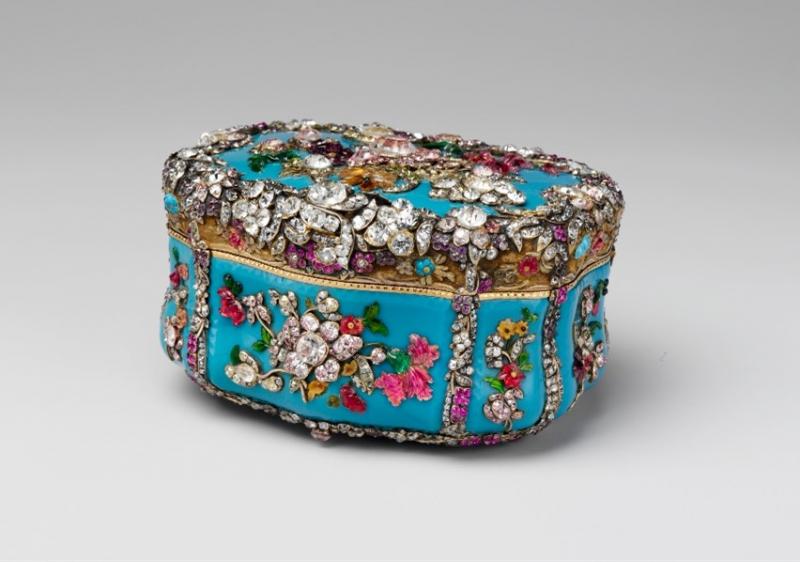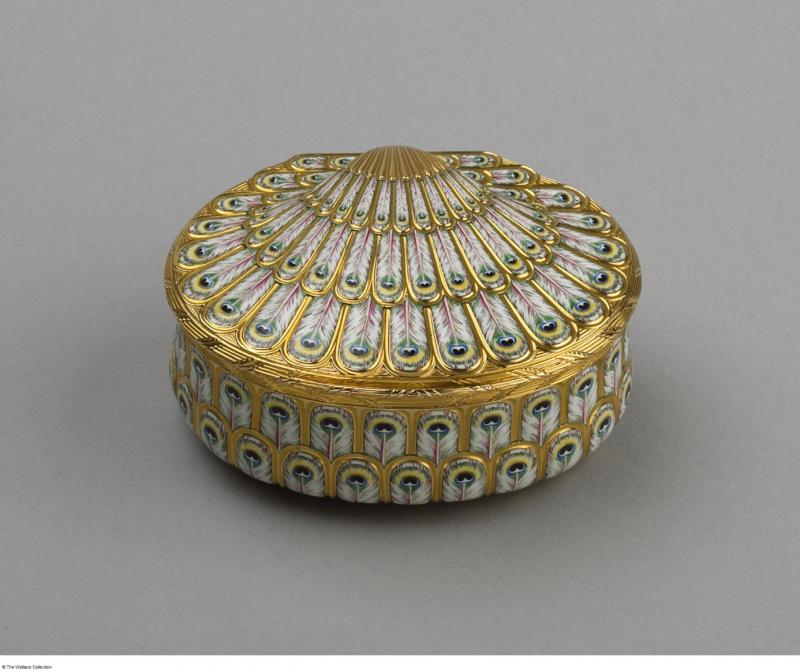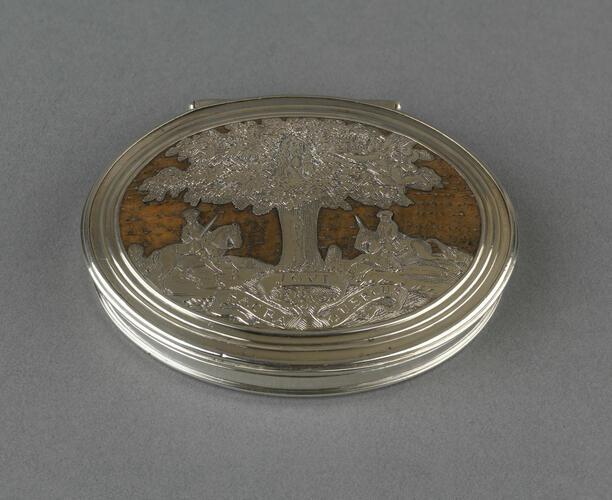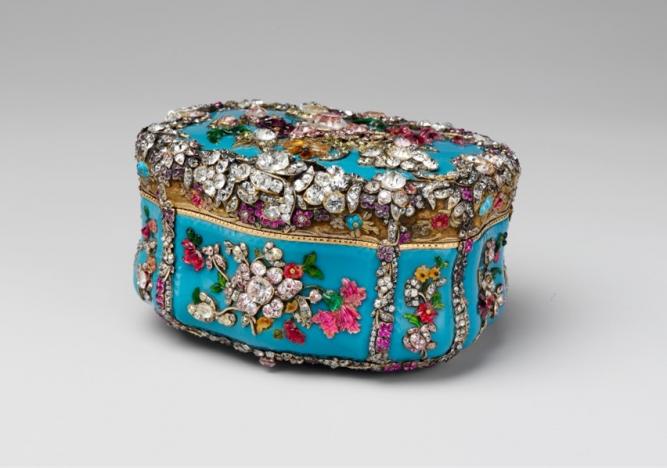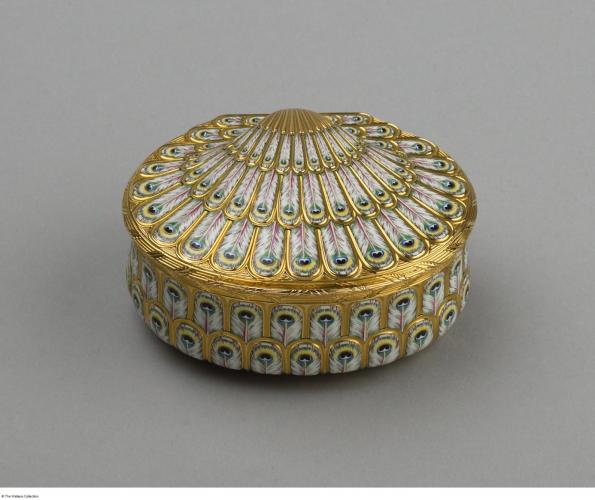Abstract
Taking snuff became a sophisticated social ritual in the 18th century. Snuff, a form of powdered tobacco, was contained and carried in specific boxes which came in various shapes and designs and ranged from luxurious objets d’art to more affordable artefacts. Significantly, as portable objects, they were constitutive accessories in the performance of fashionable sociability among the elite but also in more plebeian social circles. Their highly decorative surfaces also afforded a grammar of sociability, from ostentatious display aimed to impress to the material expression of emotions.
Snuffboxes epitomise the interconnection of fashion and sociability in the eighteenth century against the colonial backdrop of the tobacco trade between Britain, and Spain, and their American colonies. They could be carried in pockets or displayed as curiosities or as part of luxurious tableware. Various materials were used, and often combined, during the manufacturing process, ranging from minerals – gold, silver, gems and hardstones − to natural substances − lacquer, porcelain, wood − and animal materials such as horn, shell, mother of pearl, tortoiseshell, ivory and leather.
Offering a wide variety of models and prices to choose from, snuffboxes entered the markets of both luxury and ‘populuxe’1 commodities and became highly desirable and popular consumer goods. Snuffboxes acted as objects of sociability par excellence, standing as they did at the heart of a nexus of artistic, scientific, commercial relations and characterized by a multiplicity of social interactions. Being construed to be displayed in the presence of others to take or offer a pinch of snuff or to be admired as dazzling artwork, snuffboxes were coveted and used by connoisseurs and men and ladies of fashion.
- 1. The term ‘populuxe’ was defined by Cissie Fairchilds to refer to more affordable copies of expensive elite goods. ‘The Production and Marketing of Populuxe Goods in Eighteenth-Century Paris’, in John Brewer and Roy Porter (eds.), Consumption and the World of Goods (London: Routledge, 1993), p. 228-248.
The commerce of the snuffbox: fashion, shopping and social networks
The making of snuffboxes implied the social connection of different professions. Goldsmiths, enamel painters, miniaturist painters, enamellers, chasers, lapidaries, jewellers and gilders combined their skills to produce snuffboxes, while toymen and women, known as marchands merciers in France, were instrumental in providing precious materials or securing commissions, and sold these precious trinkets in their shops. Family networks were deeply involved in the business of the snuffbox. The famous Parisian goldsmiths Jean and Jean-Charles Ducrollay both managed a successful business and had their cousin Pierre-François Drouais as an associate. France was the epicentre of the flourishing taste for gold snuffboxes which grew significantly from the 1720s to the French Revolution and whose fashion spread to other European countries. The popularity of richly decorated snuffboxes led to an intense transnational circulation of commissions and gifts, linking diplomatic, social and commercial interactions. The reputation of the Ducrollay brothers’ astounding craftsmanship led royal and elite circles to commission dazzling snuffboxes from their workshops. Luxury snuffboxes granted their owners a visual expression of wealth, social rank and taste. The King of Portugal had his Ambassador in France commission a gold snuffbox studded with diamonds and emeralds, which was manufactured by Ducrollay, with the contribution of royal goldsmith Louis Roucel, and transited through the shop of marchand mercier Pierre-André Jacquemin.2
The famous shell-shaped snuffbox enamelled with peacock feathers made by Jean Ducrollay, now in the Wallace collection (London), is another example of artistic sophistication and a conspicuous display of luxury that would have drawn the admiration of those who would have seen it at social occasions. Owned by the duc d’Aumont, a famous connoisseur, the snuffbox offers a form of visual performance. When it is opened, the peacock’s tail appears majestically upright in a highly theatrical manner, reflecting, through such a mise-en-scène, the duke’s desire to stand out for his taste, to be seen and impress when opening his snuffbox at social gatherings, and to be admired for his choice sophistication. Following the revocation of the Edict of Nantes, the presence of many Huguenot families of goldsmiths and silversmiths in London meant that the skills and taste of the continent found success on British soil, as the production of the Harrache and Pantin families testifies. The world of artisans, salesmen and clients intersected every time an order was commissioned.
- 2. For an in-depth study of Paris goldsmiths Jean and Jean-Charles Ducrollay and their circle, see Bastien Vincent, ‘Jean Ducrollay et l’orfèvrerie à Paris au XVIIIe siècle’, in Stéphane Castelluccio (ed.), Le commerce du Luxe à Paris aux XVIIe et XVIIIe siècles (Bern: Peter Lang, 2009), p. 133-149.
Toyshops were also places of sociability where clients and friends met and enjoyed buying these new fashionable props for themselves or as gifts for friends. The transnational circulation of fashionable and eye-catching snuffboxes is evidenced in sociable epistolary exchanges of men and women alike. During her stay in Paris in September 1767, the famous letter writer Lady Mary Coke reported that she ‘went out to shops & bought several things’. She bought a snuffbox for one of her female acquaintances: ‘Mrs Campbell desired me to buy her a snuff box, & I think she’ll be pleased, for I never saw a prettier then [sic] I have got for her.’ (1 September 1767) When visiting her friend on 14 September, she happily delivered the order: ‘I carried her the snuff box She had desired I wou’d buy at Paris.’3
The enactment of friendship
In elite circles as well as in lower social ranks, snuffboxes were widely popular and served as the expression of friendship and love. Some models were particularly designed to convey a message on the lid, or had a miniature portrait set to it, which created an emotional tie between the giver and the recipient of the trinket and revealed their social or intimate relationship. Exchanged as gifts, snuffboxes could take part in the art of courting or as reminders and testimonies of affection between friends. Snuffboxes were thus conduits through which emotions circulated between individuals. The enamel factories of Bilston and Battersea were renowned for producing snuff, patch boxes and bonbonnières which carried mottoes such as ‘In Memory of a Friend’, ‘Remember the Giver’ or ‘This and the Giver are Thine for Ever’. Handling the snuffbox re-enacted the presence of the absentee and abolished distances, allowing the owner to travel mentally to other places and times where he/she was in the company of his/her friend. The exchange of snuffboxes materialized emotions and various degrees of bonding. From the highest aristocratic ranks to humbler middle-class circles, snuffboxes were given or exchanged as tokens of friendship. In a letter written from Geneva in 1702 in which he thanks his friend Chamberlain Dashwood for the gift of a snuffbox, Joseph Addison ascribes emotion to the object which acts as a material embodiment of their mutual affection:
- 3. Lady Mary Campbell Coke, The Letters and Journals of Lady Mary Coke, vol. 2 (Edinburgh: David Douglas, 1889), p. 116-137.
‘About three days ago Mr. Bocher put a very pretty snuff-box in my hand. I was not a little pleas’d to hear that it belonged to myself, and was much more so when I found it was a present from a Gentleman that I have so great an honour for. […] I am observ’d to have my Box offner [sic] in my hand than those that have bin [sic] used to one these twenty years, for I cant [sic] forbear taking it out of my pocket whenever I think of Mr Dashwood.’4
Here the snuffbox transited in various hands before reaching Addison, being given first by Dashwood to a Mr. Bocher to be entrusted to deliver the gift safely into Addison’s hand. Its circulation can be viewed as a materialization of the friendly network to which both Addison and Dashwood belonged.
The 'exercice of the snuffbox': performing a social ritual
Gestures to open one’s snuffbox, take a pinch or present it at social occasions were codified and interpreted as indicators of the owner’s degree of politeness. The handling of snuffboxes reflected and betrayed the character of their owners, depending on the way a pinch was taken or offered. In The Spectator n°138 (8 August 1711), a humorous advertisement for the shop of London’s famous perfumer Charles Lillie describes the ways in which a pinch of snuff could convey various moods: the gesture could appear ‘careless’, ‘scornful’, ‘politic’ or ‘surly’, depending on the manner of handling the snuffbox. Lillie playfully urges male consumers to learn the art of exercising the snuffbox in society:
- 4. Joseph Addison, ‘Joseph Addison to Chamberlain Dashwood: July 1702.’ Electronic Enlightenment Scholarly Edition of Correspondence, Robert McNamee et al. (ed.) Vers. 3.0. University of Oxford. 2018. Web. 4 Apr. 2020.
‘The exercise of the snuff-box, according to the most fashionable airs and motions, in opposition to the exercise of the fan, will be taught with the best plain or perfumed snuff, at Charles Lillie’s, perfumer, at the corner of Beaufort’s buildings, in the Strand, and attendance given for the benefit of the young merchants about the Exchange for two hours every day at noon, except Saturdays, at a toy-shop near Garraway’s coffee-house. There will be likewise taught the ceremony of the snuff-box, or rules for offering snuff to a stranger, a friend, or a mistress, according to the degrees of familiarity or distance, with an explanation of the careless, the scornful, the politic, and the surly pinch, and the gestures proper to each of them.’5
The ‘ceremony of the snuffbox’ encapsulates the highly ritualistic nature of modes of sociability around snuff consumption and the importance of the performance of bodies in the making of sociability. Whether snuff-takers were friends, mere acquaintances or utter strangers meeting for the first time, the offering gesture was to carry a degree of measure and composure whilst remaining faithful to ‘the most fashionable airs and motions’. Despite the seemingly light-hearted tone of the text, the reader is reminded of the necessity to discipline one’s body and stick to the rules of polite behaviour in the ‘exercise of the snuff-box’. For an excessive consumption of snuff was seen as impolite and unruly.
In an essay from The Universal Spectator titled ‘The Art of female conversation’, the author gently mocks the futility of female conversation and suggests considering the use of the snuffbox as a ‘polite Aid to Conversation’ to remedy female logorrhea:
- 5. Joseph Addison, The Spectator n°138, 8 August 1711.
‘In all Female Conversations there is nothing of such universal Use to fix the Reputation of a fine Talker, as the Snuff-Box. The Ladies have such a surprising Volubility of Tongue, which pours out of the Conceptions with so Vehement a Torrent of Eloquence, that it is necessary to have something to put a short Stop to it, that they may not too unwarily run themselves out of Breath; and what with more Propriety than the Snuff-Box? The agreeable Parenthesis which a Pinch of Havanna produces, has as strong an Effect to charm and Audience, as a skilful Pause in a full Concert.’6
- 6. Henry Baker, The Universal Spectator, and Weekly journal (London, December 1734), reproduced in The London Magazine: or, Gentleman’s Monthly Intelligencer, 1732-35, vol. 3, London, p. 649.
Indeed, an appropriate handling of the snuffbox acted as a metaphor of rhetorical skills in the art of pleasant conversation. The sociable grammar of the snuffbox, whose handling provided delightful pauses during conversation, relied in its performativity, eliciting social interactions, enacting the memory of loved ones and shaping the identity of fashionable individuals in tangible and material rituals of sociability.
Share
Further Reading
Alayrac-Fielding, Vanessa, ‘“A Short Recess from Talk and Tea”: The Sociable Geography of Snuff-Taking in Eighteenth-Century Britain’, Études anglaises (vol. 74, n°3, 2021), p. 284-299.
Alayrac-Fielding, Vanessa, ‘From Oroonoko Tobacco to Blackamoor Snuffboxes: Race, Gender and the Consumption of Snuff in Eighteenth-Century Britain’, Humanities (vol. 10, n°3, 2021).
Le Corbeiller, Clare, European and American Snuffboxes, 1730-1830 (New York: The Viking Press, 1966).
McShane, Angela. ‘Belonging and Belongings: Identity, Emotion and Memory stored in a Tobacco Box’, in Dagmar Freist, Sabine Kyora and Melanie Unseld (ed.), Transkulturelle Mehrfachzugehörigkeit als kulturhistorisches Phänomen: Räume − Materialitäten − Erinnerungen (Bielefeld: transcript Verlag, 2019), p. 59-82.
Murdoch, Tassa, and Zech, Heike (ed.), Going for Gold: Craftsmanship and Collecting of Gold Boxes (Chicago: Sussex Academic Press, 2014).
